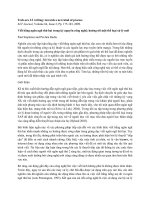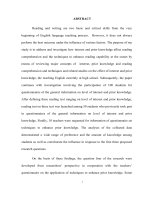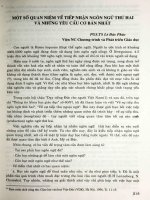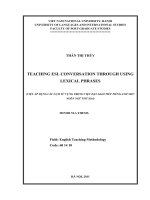Nghiên cứu về ảnh hưởng của những hoạt động kích thích kiến thức nền trong việc nghe hiểu ngôn ngữ thứ hai
Bạn đang xem bản rút gọn của tài liệu. Xem và tải ngay bản đầy đủ của tài liệu tại đây (1.15 MB, 74 trang )
VIETNAM NATIONAL UNIVERSITY, HANOI
UNIVERSITY OF LANGUAGES AND INTERNATIONAL STUDIES
FACULTY OF ENGLISH LANGUAGE TEACHER EDUCATION
GRADUATION PAPER
AN INVESTIGATION INTO THE EFFECTS
OF SCHEMATA ACTIVATION ACTIVITIES
ON L2 LISTENING COMPREHENSION
Supervisor: Nguyễn Chí Đức, Ph.D
Student: Trần Minh Thảo
Year of Enrollment: QH2014.F1.E2
HANOI – 2018
ĐẠI HỌC QUỐC GIA HÀ NỘI
TRƯỜNG ĐẠI HỌC NGOẠI NGỮ
KHOA SƯ PHẠM TIẾNG ANH
KHÓA LUẬN TỐT NGHIỆP
NGHIÊN CỨU VỀ ẢNH HƯỞNG CỦA NHỮNG HOẠT
ĐỘNG KÍCH THÍCH KIẾN THỨC NỀN TRONG VIỆC
NGHE HIỂU NGÔN NGỮ THỨ HAI
Giáo viên hướng dẫn: Nguyễn Chí Đức, PhD
Sinh viên: Trần Minh Thảo
Khóa: QH2014.F.1.E2
HÀ NỘI – 2018
ACCEPTANCE PAGE
I hereby state that I: Tran Minh Thao from QH2014.F1.E2, being a
candidate for the degree of Bachelor of Arts, accept the requirements of the
University relating to the retention and use of Bachelor’s Graduation Paper
deposited in the library.
In terms of these conditions, I agree that the origin of my paper
deposited in the library should be accessible for the purposes of study and
research, in accordance with the normal conditions established by the librarian for
the care, loan or reproduction of the paper.
Signature
Tran Minh Thao
ACKNOWLEDGEMENTS
I would like to express my sincere gratitude to my supervisor, Dr. Nguyen
Chi Duc, for untiring supporting me during these 7 months. He is the most
dedicated person and one of the most knowledgeable people I have ever known.
He always provided insightful comments that helped me to view issues from
various perspectives. Although I had many shortcomings, one of which was my
weak research skill, he still patiently guided and encouraged me from the
beginning till the end. He is my best role model for a scientist, a mentor and a
teacher. I could not have imagined a better supervisor for this journey.
Next, a very special gratitude goes to all teachers and students in University
of Languages and International Studies, Vietnam, who willingly spent time
participating in my study. Without their help, I would not have been able to
complete this thesis.
I also thank to my beloved friends for their care, their wishes and their
encouragement. Special thanks to Bui Quynh Trang, Pham Hong Ngoc, Nguyen
Vu Quoc Duy, Nguyen Thu Tra, Nguyen Ngoc Anh and Luong Huyen My who
listened and offered me valuable advice when I needed support.
Last but not least, I am deeply grateful to my family. My special and
heartily thanks to my mom who pushed me to complete this thesis, cheered me up
when I felt down about myself, stayed up with me through some sleepless nights
and always believed in me.
ABSTRACT
This research project investigates the effects of using text-relevant
schemata activation activities on listening comprehension of EFL sophomores of
University of Languages and International Studies. The research subjects were
divided into three groups, two receiving an experimental treatment (either formal
or content schemata) and a control group receiving no treatment. At the end of
treatment, a listening test including a summary writing task and a set of
comprehension questions was administered to all groups. The analysis of the test
scores revealed that the formal and content schemata activation activities
significantly facilitated learners’ L2 listening comprehension. Between these two
listening supports, the former brought about a slightly better listening outcome
than the latter. Additionally, question types and learners’ general listening
proficiency were two factors that moderated the effects of schemata activation on
L2 listening comprehension. Learners performed greater on global questions than
local question and high proficiency learners were found to benefit more from the
formal schemata activation activities than low level counterparts. Regarding the
pedagogical implications, this study informs teachers and course designers in their
decision-making to select and/or design suitable pre-listening activities to foster
learners’ listening comprehension.
TABLE OF CONTENTS
INTRODUCTION ................................................................................................... 1
1. Statement of the problem and rationale for the study .......................................... 1
2. Research aims and research questions ................................................................. 3
3. Potential contributions .......................................................................................... 3
4. Research methodology ......................................................................................... 4
5. Structure of the study ........................................................................................... 5
CHAPTER ONE: LITERATURE REVIEW .......................................................... 6
1. Listening comprehension .................................................................................... 6
1.1. Definition of listening comprehension ................................................... 6
1.2. The process of listening comprehension ................................................ 7
2. Schema .............................................................................................................. 10
2.1 Definition of schema ............................................................................ 10
2.2. Types of schema ................................................................................... 12
3. Roles of schema activation in listening comprehension .............................. 13
CHAPTER TWO: METHODOLOGY ................................................................. 21
1. Overall research design and research aims............................................................. 21
2. Research participants .............................................................................................. 23
3. Input materials ........................................................................................................ 24
4. Data collection instrument ...................................................................................... 25
4.1. Pre-listening test .............................................................................................. 25
4.2. Post-listening test............................................................................................. 26
5. Procedures of data collection ......................................................................... 27
5.1. Formal schemata activation group .................................................................. 27
5.2. Content schemata activation group ................................................................. 28
5.3. Control group................................................................................................... 28
6. Data analysis .................................................................................................. 39
CHAPTER THREE: RESULTS ............................................................................ 30
1. The overall listening comprehension scores ...................................................... 30
2. The scores on the summary measure ................................................................. 32
3. The scores on the specific question measure...................................................... 34
4. The scores on the inference question measure ................................................... 36
5. Overall summary ................................................................................................ 38
CHAPTER FOUR: DISCUSSION AND IMPLICATIONS ................................. 39
1. Discussion............................................................................................................... 39
2. Implications ............................................................................................................ 41
2.1. Pedagogical implications ................................................................................. 41
2.2. Research implications ...................................................................................... 42
CONCLUSION ...................................................................................................... 44
1. Summary of research findings ............................................................................ 44
2. Limitations of the study ...................................................................................... 45
REFERENCES ...................................................................................................... 46
APPENDIXES ........................................................................................................ 52
LIST OF TABLES, DIAGRAMS AND ABBREVIATIONS
TABLES
Table 1: Zeng’s techniques to trigger stored schemata .......................................... 13
Table 2: Nguyen and Newton’s techniques for schemata activation ..................... 14
Table 3: Summary of Chang and Read’s procedures of data collection ................ 16
Table 4: Research Design ....................................................................................... 22
Table 5: The Overall Listening Comprehension Scores ........................................ 31
Table 6: Scores on the Summary Measure ............................................................. 33
Table 7: Scores on the Specific Question Measure ................................................ 35
Table 8: Scores on the Inference Question Measure .............................................. 36
DIAGRAMS
Figure 1: Cognitive Processes and Knowledge Sources in Listening
Comprehension ......................................................................................................... 8
Figure 2: A person’s possible schema of an egg .................................................... 11
ABBREVIATIONS
L2
Foreign or Second Language
IELTS
International English Language Testing System
CEFR
Common European Framework of Reference for Language
ESL
English as a Second Language
EFL
English as a Foreign Language
INTRODUCTION
This initial section aims to give an overview of this research report.
First, the rationale for this study will be presented, which is subsequently followed
by the research aims and the contribution that this study can make to research and
instruction practices. Most importantly, the research questions which work as a
guideline for the whole research project will also be stated in this section.
1. Statement of the problem and the rationale of the study
Listening is often regarded as the most frequently used language skill in
normal life (Rost, 2001), which therefore deserves to have an important place in
language teaching and learning agenda (Rost, 2001; Vandergrift, 2004).
Significant though it may seem, it has been considered “the Cinderella of the four
language skills” [i.e., speaking, reading, writing and listening] (as cited in Peter,
Guangwei & Lawrence, 2009). This might be partially reflected in the paucity of
research on L2 listening and therefore more investigations into this language skill
are still welcomed.
According to Vandergrift (2004, p.3), “listening is probably the least
explicit of the four macro language skills, making it the most difficult skill to
learn” and therefore to teach as well. Chang and Read (2006) also supported the
view above. Goh (2000) even identified ten cognitive problems regarding L2
listening comprehension, such as: L2 lexical segmentation and recognition, limited
capacity of human working memory and challenging nature of real-time listening.
Goh also attributed these problems to many factors, one of which was learners’
failure to use relevant schematic knowledge to facilitate their listening processes.
Schematic knowledge includes content schemata and formal schemata. While the
first one refers to topical knowledge or knowledge about the world outside, the
latter refers to knowledge about the structure of a given text. Grabe (1991) pointed
out that, to comprehend a spoken or a written text, L2 learners need both types of
1
schematic knowledge above. This therefore suggests that schema activation should
not be neglected in L2 listening instruction. However, previous research to date
has provided rather inconsistent findings regarding the effects of schema
activation activities on L2 listening comprehension. Some studies (e.g., Taglieber,
Johnson & Yarbrough, 1988; Chang & Read, 2006; Sadighi & Zare, 2006) found
that L2 listening process was facilitated by different schema activation activities.
In contrast, other studies (see Jensen & Hansen, 1995; Sarandi, 2010 for example)
were dubious about the effectiveness of such activities on L2 listening outcome.
Jensen and Hansen (1995) even reported a negligible impact of prior topical
knowledge on L2 listening performance. What seemed to play important roles in
lecture comprehension were other factors [e.g. types of listening tasks].
All the aforementioned studies dealt with schemata activation and its
effects on L2 listening. However, it should also be noted that most of them
focused on the content rather than the formal schemata. Very few have examined
the effect of formal schemata activation on L2 listening comprehension. So far,
according to Nguyen and Newton (2018), there has been only one study by Tudor
and Tuffs (1991) that gauged the effects of a formal schemata activation activity
on L2 listening outcome. In this study, Tudor and Tuffs found out that activating
formal schemata before listening brought about better text comprehension than
activating content schemata. Given the scarcity of empirical research in this area,
the hypothesis above still need to be further verified. Moreover, the study by
Tudor and Tuffs (1991) has several limitations, one of which is concerned with the
ambiguity in distinguishing the two key concepts “content schemata” and “formal
schemata”, which I will discuss further in the literature review chapter.
All research gaps above have motivated me to carry out this research
project. In addition, findings from this research project are also expected to
inform teachers of L2 listening in their decision-making process regarding how to
select or design supporting activities in the pre-listening stage.
2
2. Research aims and research questions
First of all, this study is to investigate the effects of a formal and a content
schemata activation activity on L2 listening comprehension. Next, it also gives a
closer look at the relationship between the degree of learners’ text comprehension
and their general L2 listening ability. Put differently, this research project is
implemented to answer the following research questions:
1. Does activating schemata before listening have any effect on text
comprehension of the participants?
2. Is better text comprehension obtained in the formal than the content
schemata activation condition?
3. Is this effect (if any) also dependent by the type of comprehension
questions?
4. Is the text comprehension obtained by these two groups associated with
participants’ general L2 listening ability?
3. Potential contributions
Once finished, the study will provide further empirical evidence for the
effects of schemata activation in general and formal schemata activation in
particular on L2 listening comprehension. In addition, as previous research failed
to make a clear distinction between the two key concepts “content schemata” and
“formal schemata” in their research design, this study also aims to fill this gap.
Regarding pedagogical values, this research project expected to inform
teachers and course designers in their selection and/or design of schemata
activation activities that are deemed to foster learners’ listening processes.
4. Research Methodology
3
In order to achieve the research aims, the study employs a quasiexperimental research design. Three groups are involved, two of which receive
treatments and the other serves as the control group. The independent variables in
this study are content and formal schemata activation activities and the dependent
variables are the listening performances of the experimental and the control group.
After the treatment, the test scores of three groups are compared to see the effects
of the treatment in the experimental groups.
5. Structure of the study
Apart from the introduction and the conclusion section, this research report
includes the following chapters:
Chapter 1: Literature Review
This chapter aims first to provide the fundamental theoretical
background to the present research project. To be more specific, I will define
related key concepts such as listening comprehension and schemata and then
describe the relationship between these two factors. Finally, a critical review of
previous research findings is also presented in this chapter.
Chapter 2: Methodology
This chapter is to restate the research questions, describe the overall
research design, research participants, instrument as well as procedure for data
collection and data analysis.
Chapter 3: Results
In this chapter, I shall report key findings from this research project.
These findings will be organized according to the research questions mentioned
above.
Chapter 4: Discussion and Implications
4
In this chapter, I will propose some plausible explanations for the findings
above. In addition, these findings will be compared and contrasted with those of
previous research. Finally, implications will be drawn out for both research
instruction practices.
5
CHAPTER 1: LITERATURE REVIEW
This chapter aims to set the theoretical background for the whole research
project. In this chapter, key concepts of listening comprehension and schemata
will be presented. Subsequently, a brief review of previous research will be
carried out to identify the research gaps.
1. Listening comprehension
1.1. Definition of listening comprehension
Listening comprehension has been defined differently to date or, in other
words, there is no consensus on the definition of this concept (Chun, 2011; Buck,
1988). Glen (1989), for example, examined a collection of thirty-four different
definitions of listening comprehension in his study and then admitted his failure to
reach a universal definition. Listening comprehension used to be defined as the
ability to understand what a person has heard (Howatt & Dakin, 1974; Brown &
Yule, 1983). This included the ability to comprehend speakers’ accent,
vocabulary, grammar, pronunciation and his/ her meaning. Later, Chastain (1971)
further added that the ultimate goal of listening comprehension was to understand
natural conversations at normal speed in an unstructured condition.
In a disagreement with the above concept of listening comprehension,
Baki -Miri
(2012, p.83) claimed that listening comprehension might be
something going beyond the ability to hear and comprehend what other people
said, it “involves etiquette, asking for clarification, showing empathy and
providing an appropriate response”.
From another perspective, Anderson and Lynch (1988) criticized the norm
of viewing listening as a passive language skill in which learners were considered
6
“tape recorder or trained parrot”. They pointed out that listening comprehension
was a process requiring listeners to relate his/her previous knowledge to listening
input in order to comprehend what was being spoken. Many scholars shared a
similar opinion. Helgensen and Brown (2007), for example, regarded listening as
an “active” receptive skill. O’Malley, Chamot and Kupper (1985) stated that as
listeners needed to use their existing and contextual knowledge to understand
input content, listening comprehension should be viewed as an active and
conscious process. Rost (2009) also argued that listening was indeed an active
cognitive ability which helped learners to understand the world around them and
was one of the necessary elements in creating successful communication.
In
conclusion,
there
exist
different
points
of
view
on
the
construct/definition of listening comprehension. However, most scholars have
agreed that listening comprehension involves selecting and integrating information
from auditory and visual input and relating it to previous schemata in order to
construct the meaning and intention of speakers. Therefore, my current research
project will use this definition of listening comprehension.
1.2. The process of listening comprehension
According to Vandergrift and God (2012, p.28), the listening process can
be diagrammed as in the figure below:
7
Figure 1: Cognitive Processes and Knowledge Sources in Listening
Comprehension
The figure shows that the process of listening comprehension includes three
interconnected phases: perception, parsing and utilization. Perception (also called
as perceptual process) is the decoding of an aural text. During this phase of
listening, listeners attend closely to the input and make an effort to segment
phonemes from the speech stream and the sounds are retained in echoic memory.
The second phase, parsing, involves translating word representation into
meaningful representation. This occurs when an utterance is segmented according
to syntactic structures or semantic (meaning) cues. In the final process, utilization,
the listener relates these mental representations to the existing knowledge stored in
their long term memory. In other words, the listener tries to comprehend the new
information by relating it to old information, and then make inferences to respond
to the speaker. Goh (2000), who investigated cognitive listening problems faced
8
by second language learners, suggested that low-ability listeners reported more
problems related to the perception and then parsing than the utilization phase.
In addition, listening comprehension process is normally believed to be
constructed on the two principal sources of information which are referred to as
linguistic knowledge and prior information. These sources of knowledge are
derived from two listening processes which are bottom-up and top-down.
Bottom-up processing is a process of using linguistic knowledge to
interpret the meaning of a given message. To be more specific, it is seen as a
decoding process in which phonemic units are decoded and connected together
to make words; words are connected together to form phrases; phrases are
connected to make utterances; and utterances are connected to make a complete
text. During this combination of such linguistic components, listeners gradually
construct meaning from the minimal units to increasingly larger units of meaning.
Top-down processing, on the other hand, involves the application of
context and prior knowledge to help listeners understand the meaning of whole
text. To be more specific, listeners who approach a comprehension task in a topdown manner use their relevant prior knowledge and experience to predict, filter,
analyze and interpret perceived information. According to Vandergrift (2002),
prior knowledge can be knowledge of the topic, the listening context, the texttype, the culture or other information stored in long-term memory as schemata,
which will be described in more detail in Section 2 of the literature review chapter.
In fact, listening comprehension is neither merely top-down nor bottom-up
processing, but an inter-dependent combination of these two processes. In other
words, if top-down processing brings meaning to the text through schemata
activation, learners have more cognitive resources left to work on decoding
information at word level (i.e., bottom-up processing). It is, therefore, important to
note that listening comprehension is influenced by information that an individual
9
stores in their long-term memory. Thus, this relevant schema must be activated to
enhance listening.
In short, listening comprehension involves two distinct processes (bottomup and top-down) and three phases (perception, parsing, utilization) with two
principal sources of knowledge (prior topical knowledge and linguistic
knowledge). In these processes, prior knowledge (schemata) is an indispensable
component, which is mainly focused in the current study.
2. Schema
2.1. The definition of schema
The term “schema” (its plural form: schemata) was first used by Frederic
Bartlett (1932) who was a British psychologist, referring to “an active organization
of past reactions or of past experiences” stored in our memory. Subsequently, this
term became more popular since 1970s thanks to the development of cognitive
psychology and cognitive science. Until now, there have been many definitions of
this concept.
Like a number of other scholars (e.g., Rumelhart 1980 ), Minsky (1975)
proposed a “frame” concept when defining schema. In his conception, schemata
are symbolic knowledge structures, including fixed structural relationships
between different attributes. The following passage is an example:
“It can be hard work going down, but luckily the facilities make it much easier
going up. Keep them pointed upwards, and be careful when you exit so you don’t
stop things from moving. Be on the lookout for others who are having difficulty,
and watch out for the edges!”
At first, this passage is ambiguous and difficult to interpret; however, when
cues about the appropriate schema (snow skiing) are provided, the passage
becomes more meaningful and easier to understand (Bransford & Johnson, 1972 )
10
Alba and Hasher (1983) defined schema as general knowledge that a person
processes about a particular domain, which Sanford and Garrod (1981) used the
term “scenario”, instead. Similarly, Cook (1997) defined schema as “a mental
representation of a typical instance” (p.86). The following is an example of
schema for “egg”
Figure 2: A person’s possible schema of an egg (Davis, 1991, p.24)
According to Brown and Yule (1983), schema is regarded as organized
background knowledge which can help people to make predictions and
expectations within their interpretation. They say that our background knowledge
is organized and stored in some fixed schemata, together with some other flexible
schematic structures.
For example, we might have schemata for a classroom which includes
chairs, tables, blackboard, and bookshelves; therefore, each time we enter a
classroom, we do not need to consider those elements above. When being given a
11
new situation in which we are required to read a text about a third-grade classroom
in a book, we still can flexibly use our established classroom schemata to predict
its appearance.
Although there have been various definitions of schema, it can be seen that
almost all definitions stem from Bartlett’ concept. To put it simply, schema is an
abstract knowledge structure gained through past experiences and stored in one’s
mind whose main function is to help us interpret new information.
2.2. Types of schema
Schemata are classified into two types, namely formal schema and content
schema (Carrell, 1983). The former deals with the background knowledge of
discourse forms, such as: stories, poets, newspapers, research reports, which guide
learners to decode organizational forms and rhetorical structures of those texts. For
example, the formal schemata underlying many stories are the story setting,
followed by a series of events, and then the final resolution. The story normally
begins with a setting in which the time, the place and the main characters are
identified. Then a series of events (normally problems and conflicts) are presented
before the final solution is described. Different genres have different rhetorical
structures. Lack of such kind of knowledge also contributes to problems in
listening comprehension.
Content schemata, on the other hand, refer to factual knowledge and prior
experience with a particular subject, helping listeners to predict, select information
and comprehend a given text. For example, schemata for going to a restaurant
would include information about menus, services, food order, and bill payment.
Content schemata are largely culture-specific. Therefore, cultural schemata are
usually categorized in the realm of content schemata.
3. Roles of Schemata Activation in Listening Comprehension
12
Many scholars in this field consent that listening comprehension depends
on learners’ successful activation of relevant schemata (Taglieber, Johnson &
Yarbrough, 1988; Brown, 2000). According to Taglieber, Johnson, and Yarbrough
(1988), comprehension takes place when listeners make use of their schemata
about a given topic. Brown (2006) gave an example of a listening task in
classroom whose goal is to listen to job titles. According to him, prior to listening,
it was necessary to give students the chance to apply their schematic knowledge in
completing this task [e.g., ask students to list jobs they know in English]. He
added that not only did this activity facilitate learners’ listening comprehension
but it also motivated students themselves by bringing their lives to lesson. Zeng
(2007) suggested the following techniques to activate stored schemata (see Table
1).
Activity
Brainstorming
How to do
Purpose
Call out related words or phrases to be put on the These
board or OHP
knowledgeoriented
Mind-mapping
Discussion
Write down words or draw simple pictures in a
web
activities aim to
prepare students
Discuss similar or related issues based on
prompt questions or pictures
by encouraging
them to activate
stored schemata
Games
Use simple word or information-gap games
or
acquire
relevant types of
Guide-questions
Picture/Diagram
Guess answers to questions on the text
Complete illustrations with simple drawings or
words
world
knowledge
in
order
to
facilitate
13
their
top-
Predict contents, characters, setting or sequence
Predictions
down
processing.
of events
Identify the odd one out from a group of pictures
Elimination
or words/phrases
Skimming
Read a related short text for gist
Table 1: Techniques to trigger stored schemata (Zeng, 2007)
Furthermore, Nguyen and Newton (2018) suggested some more
activities in order to activate listeners’ prior knowledge. They even identified
specifically which type(s) of schemata is/are activated regarding each technique.
Goal
Content schemata
Formal schemata
Provision/Preview
Key words
Topic
Audiovisual input
Rhetorical structure
Summary
Sequenced pictures
Comprehension questions
Table 2: Techniques for schemata activation (Nguyen & Newton, 2018)
14
Thanks to these activities, L2 listening comprehension became easier
in the regard that schema activation encouraged listeners to use what they already
knew and integrated the prior knowledge into acquiring new knowledge.
Chang and Read (2006) investigated the effect on L2 listening
comprehension of schemata activation through four listening-support activities,
namely comprehension-questions preview, input repetition, topic preparation and
vocabulary instruction. For the sake of the study, 160 business majors at the
college in Taipei, Taiwan were recruited and randomly assigned into four groups.
Following is the table summarizes four treatments in four groups:
PQ
RI
TP
VI
No test
No test
Read topic-related
Study topic-related
preparation; listen
preparation; listen
material and
vocabulary and
to textbook CD
to textbook CD
discuss the topic
listen to how it is
with the teacher
pronounced
Preview questions
Listen once
Preview questions
Preview questions
Listen once
Preview questions
Listen once
Listen once
Listen twice
Note: PQ = preview the questions; RI = repetition of the input; TP = topic
preparation; VI = vocabulary instruction.
Table 3: Summary of four treatments
15
After listening to two short talks, all learners were given an
immediate comprehension question test to measure their level of text
comprehension. An interview was also employed to elicit participants’ attitudes
towards the listening supports above and the strategies that they applied in
completing the task. The findings showed that providing information about the
listening topic was the most useful type of support, followed by input repetition
and comprehension-question preview. Vocabulary preview was the least effective
one.
Another study was conducted by Jafari K and Hashim (2012) among
108 EFL sophomores at Ghaemshahr Azad University in Iran. For the purpose of
this investigation, they divided these participants into one control group and two
experimental groups (vocabulary preview and main ideas preview). Prior to
listening, students in vocabulary teaching group were provided with a list of
vocabulary items, while students in the other experimental group received a list of
key sentences. In the control group, students did not receive any kind of prelistening activity but had a chance to listen twice and read the comprehension
questions between two times listening. At the end of the experiment, researchers
conducted an interview with 12 students with a view to obtaining information
about students’ ideas and reflections on the use of different advance organizers in
class. The findings demonstrated that the two treatment groups outperformed the
control group; however, there was no significant difference between these two
conditions. This therefore implied that teaching any kind of pre-listening activities
whether the main ideas of the passage or teaching vocabulary items could activate
students’ prior knowledge, making the listening input more meaningful. This
quantitative result was consistent with their attitude and perception of pre-listening
activities, in which they were highly interested in having these activities as regular
activities in class.
16









